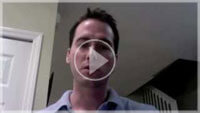Part Three: Molecular Orbitals, Hybridization and Geometry
- Atomic orbitals
- Remember these subshells from general chemistry?
- s
- p
- d
- etc.
- Each subshell has a certain number of atomic orbitals (represented by the lines below)
i. s 
one orbital ii. p 
three orbitals iii. d 
five orbitals - Each atomic orbital can accommodate two electrons
- Remember these subshells from general chemistry?
- Hybridization
- A hybrid or a mix of atomic orbitals
- An atom's orbitals can interact with other atoms and overlap to form a given hybrid atomic orbital
For example- here the sp hybrid atomic orbital is formed:

- Molecular Orbitals
- Molecular orbital =overlap of two atomic orbitals from different atoms
- There are two types of bonds formed in molecular orbitals: sigma bonds and pi bonds.
- sigma bond (σ)= overlap of hybridized orbitals along the line between nuclei
- single bonds are sigma bonds
- double and triple bonds each have one sigma bond
- pi bond (π) = sideways overlap between two p orbitals
- double bonds have one pi bond
- triple bonds have two pi bonds
- there must be a sigma bond in order for a pi bond to occur
- Summary Chart
Bond Sigma bonds Pi bonds Total Single 1 0 1 Double 1 1 2 Triple 1 2 3 - Geometry
- An atom has a given hybridization depending on the number of bonds extending from it
- There is also an implicit geometric shape associated with the hybridization
- Furthermore, the bond angles formed are important
- Here is a chart that sums this up:
Bond Hybridization Geometry Bond angle Picture Single sp3 Tetrahedral 109.5° 
Double sp2 Trigonal planar 120° 
Triple sp Linear 180° 
- Ways carbon can bond to others
- Option #1: Carbon may accommodate four single bonds

- Option #2: Carbon may accommodate one double bond and two single bonds

- Option #3: Carbon may accommodate two double bonds

- Option #4: Carbon may accommodate one triple bond and one single bond

- Option #1: Carbon may accommodate four single bonds
Part Three Exercise Set
Instructions:
- Use what you learned in Part Three to complete the following exercises.
- Exercise #1: The arrows point to different carbon atoms in the following molecule that are lettered a, b and c. Determine the hybridization and bond angles for each. The arrow points to the vertex of the angle formed.
- Exercise #2: The arrows point to different bonds in the following molecule that are numbered 1, 2 and 3. Determine the bond type and the number of sigma bonds (σ) and pi bonds (π) for each.
- We recommend you draw your response on plain white paper. When ready, click on the window to reveal the answer.

Exercise #1
| Arrow | Hybridization | Bond Angle with arrow at vertex |
|---|---|---|
| a |  sp2
|
 120°
|
| b |  sp
|
 180°
|
| c |  sp3
|
 109.5°
|
Exercise #2
| Arrow | Bond type | Number of sigma bonds | Number of pi bonds |
|---|---|---|---|
| 1 |  double
|
 1
|
 1
|
| 2 |  triple
|
 1
|
 2
|
| 3 |  single
|
 1
|
 0
|





